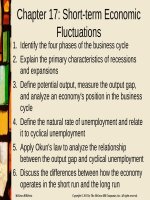Lecture Principles of economics (Asia Global Edition) - Chapter 24
Bạn đang xem bản rút gọn của tài liệu. Xem và tải ngay bản đầy đủ của tài liệu tại đây (650.55 KB, 10 trang )
<span class='text_page_counter'>(1)</span><div class='page_container' data-page=1>
Aggregate Demand,
Aggregate Supply, and
</div>
<span class='text_page_counter'>(2)</span><div class='page_container' data-page=2>
Learning Objectives
1. Define the aggregate demand curve, explain why
it slopes downward, and explain why it shifts
2. Define the aggregate supply curve, explain why it
slopes upward, and explain why it shifts
3. Show how the aggregate demand curve and
aggregate supply curve determine output and the
inflation rate over the business cycle
4. Analyze how the economy adjusts to
</div>
<span class='text_page_counter'>(3)</span><div class='page_container' data-page=3>
The Great Recession in U.S.
• Began December 2007
• Most lengthy and severe recession since the
great depression
• Causes:
– Large housing price bubble burst in July 2006
• 30% decline in housing prices over next 18 months
– Financial panic in the fall of 2008
• Difficult to borrow
</div>
<span class='text_page_counter'>(4)</span><div class='page_container' data-page=4>
Aggregate Demand and
Aggregate Supply
• Analyze fluctuations in both output and the inflation rate
– Short run and long run analysis
• Inflation rate and output on the axis
• AD shows the relationship
between planned spending
and the inflation rate
• AS shows how output
produced by firms depends
on the inflation rate
• Potential output is shown
to measure output gaps
</div>
<span class='text_page_counter'>(5)</span><div class='page_container' data-page=5>
Long-Run Equilibrium
• In the long run,
– Actual output equals potential output
– Actual inflation rate equals expected price level
• Long-run equilibrium
occurs at the intersection of
– Aggregate demand
– Aggregate supply and
– Potential output
Aggregate
Demand
Aggrega
te
Supply
</div>
<span class='text_page_counter'>(6)</span><div class='page_container' data-page=6>
Short-Run Equilibrium
• Short-run equilibrium occurs when the AD and
AS curves intersect at a level of output
different from Y*
– Point A in the graph
• Short-run equilibrium is
temporary
• Caused by a shift in
• either AD or AS
Output Y
AD
AS
Y* Y
</div>
<span class='text_page_counter'>(7)</span><div class='page_container' data-page=7>
The Aggregate Demand Curve
• The aggregate demand curve shows the
amount of output consumers, firms,
government, and customers abroad want to
purchase at each inflation rate
– All else the same
– Slopes downwards
– A higher inflation rate reduces planned aggregate
</div>
<span class='text_page_counter'>(8)</span><div class='page_container' data-page=8>
Shifts in the Aggregate Demand
Curve
• A shift of the aggregate demand curve is
called a change in aggregate demand
• At the given inflation rate, something causes
output to rise (an increase in aggregate
demand) or fall (a decrease in aggregate
demand)
• Two main causes:
– Demand shocks
</div>
<span class='text_page_counter'>(9)</span><div class='page_container' data-page=9>
Shifts in the Aggregate Demand
Curve
• <b>Demand shocks are changes in planned </b>
spending not caused by a change in output or
a change in the inflation rate
– Consumer confidence
– Consumer wealth
– Business confidence
– Opportunities for firms
to purchase new
</div>
<span class='text_page_counter'>(10)</span><div class='page_container' data-page=10>
Shifts in the Aggregate Demand
Curve
• <b>Stabilization policies are government policies </b>
used to affect planned aggregate expenditure
and eliminate output gaps
• Fiscal policy
– Change in government
spending or taxes
• Monetary policy
– Change in the nominal
money supply which
changes the interest AD
</div>
<!--links-->









